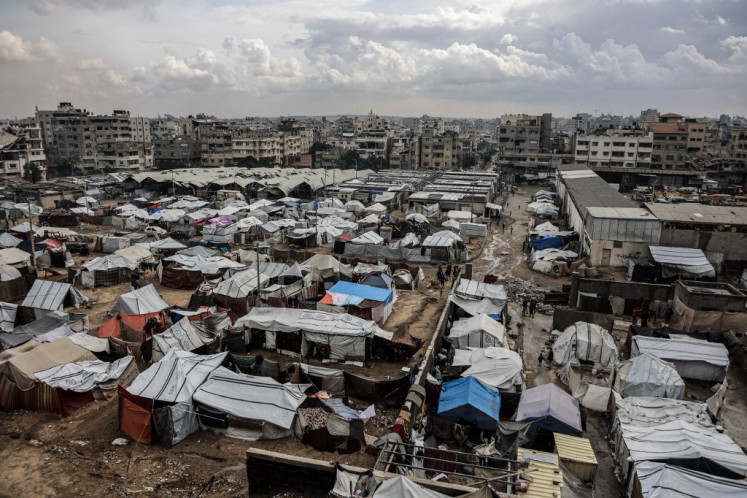Popular Reads
Top Results
Can't find what you're looking for?
View all search resultsPopular Reads
Top Results
Can't find what you're looking for?
View all search resultsHandiwirman Saputra’s enigmatic world
Hari Ini Esok Kemaren (Today Tomorrow Yesterday) by Handiwirman Saputra
Change text size
Gift Premium Articles
to Anyone
Hari Ini Esok Kemaren (Today Tomorrow Yesterday) by Handiwirman Saputra. (Venice Art Biennale/Francesco Galli)
Indonesian artist Handiwirman Saputra believes art should not be seen in black and white, and for him, artwork is just a medium to communicate beauty from the creator’s perspective.
Handiwirman failed to finish his education at the Indonesia Art Institute (ISI) but that did not stop him from receiving international recognition for his enigmatic works.
He recently returned from Italy, where he showcased his works at the 58th Venice Art Biennale, to take some time off for a simple holiday with his children in Yogyakarta.
Handiwirman recalled that they had complained when he was preparing for the exhibition because he was rarely seen at home for months.
“I was in my studio every day, working until midnight. By the time I was home, they were already asleep. I even worked on Sundays,” the father of three said, laughing.
“They demanded that I fulfill my promise to spend most of my time with them. I am not allowed to visit my studio now.”
Handiwirman made a name for himself as the third Indonesian artist to be invited to participate in the Venice Art Biennale after maestro painter Affandi in 1954 and renowned artist Heri Dono in 2003.
Coming under the theme of “May You Live in Interesting Times”, the exhibition, which runs until Nov. 24, showcases five of his works, such as paintings Hari Ini Esok Kemaren (Today Tomorrow Yesterday) and Tak Berakar Tak Berpucuk (No Root No Shoot) along with a three-dimensional artwork called Menahan Letakan di Bawah Sangkutan (Holding Placement Under Suspension).
Handiwirman’s artworks are diverse in shape, material and medium, but they all have one thing in common, they are enigmatic.
Menahan, for example, is not obvious in shape. At a glance, it looks like tree trunk overgrown with moss.
Handiwirman Saputra (Photo by A. Kurniawan Ulung)According to Handiwirman, Menahan does not depict a trunk. It is just a chunk. The green plant implies that the chunk is not going anywhere for a very long time, which is a sign that nature has fully accepted its presence so that it does not have a reason to leave.
Handiwirman said simple daily objects were the main inspiration for his artworks.
“Ideas are not something that I look for intentionally. They cross my mind out of the blue when I am doing an activity,” Handiwirman said.
“When I see a flowerpot, for example, it can quickly become a source of inspiration.”
He believes that in nature, all things are meaningful and aesthetically pleasing, depending on which side they are observed from.
“In my eyes, what people dispose of is valuable and can be the object of my work, such as a used plastic bag that I painted on Hari Ini Esok Kemaren,” he said.
For him, the characteristics of an object that draws his attention are way more important than the visual look of it. That is why it appears unrecognizable when he paints it on canvas or makes three-dimensional objects depicting it.
A rubber band, for instance, can be a meaningful object for Handiwirman. The rubber band is so elastic that it can be shaped into various forms. However, it is breakable no matter how strong it is.
“Like a rubber band, patience also has limitations. We can run out of it like a rubber band that can break if it is overstretched. That is how I create content for my work,” he said
Handiwirman said none of his work had been triggered by social or political issues in the country.
“Yes, an artist can talk about politics through his or her work. But, is it able to change the situation? I don’t think so,” he said. “If I want to talk about politics, I would prefer to be a politician rather than an artist.”
Showcased: Handiwirman's work is on display at the 58th Venice Art Biennale. (Venice Art Biennale/Italo Rondinella)Handiwirman does not have an objections to those who say his work is hard to understand. He says that he is not the type of artist to state his feelings openly, something that he says is also the way people are in his hometown of Bukittinggi, West Sumatra.
Bukittinggi is the third-largest city in West Sumatra and it was the birthplace of Handiwirman 44 years ago.
His dream job was to work in an area related to carpentry. When seeing a house built by his father, he thought that he could make a better one if he mastered carpentry. He then moved to Yogyakarta in 1993 to continue his studies at the Indonesia Art Institute (ISI), majoring in kriya (craft) to realize his dream.
It turned out that the major disappointed him because its curriculum focused on sculpturing, not carpentry.
At ISI, Handiwirman then spent most of his time in classes of other majors to study other art forms, including painting. His artistic skills grew there.
“In Bukittinggi, I never knew what art meant. My parents were also not artists,” he said.
Handiwirman, however, dropped out of ISI after missing too many kriya classes. From the start, he thought that completing his studies would be impossible, not only because he felt that he did not possess talent in sculpturing but also because deep in his heart, he never wanted to be a professional sculptor.
Being a dropout did not stop him from learning. He believes school isn’t necessarily the only place to learn art.
“You can be an artist even if you’re just a high school graduate. You can learn to make artwork from discussions with artists you make friends with. That is real art school,” he said.
“Art is liberating.”












